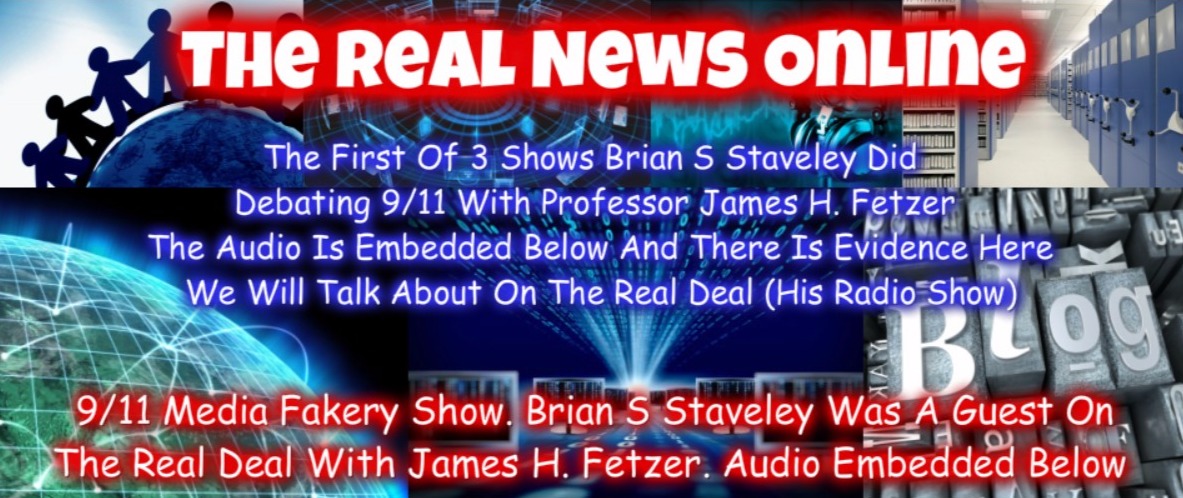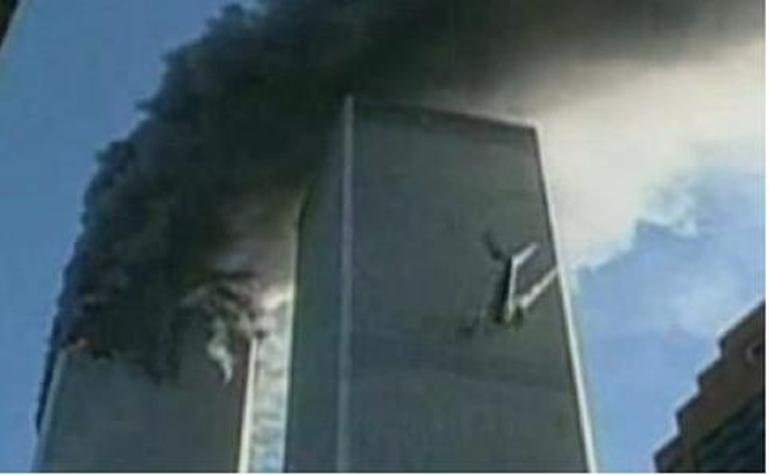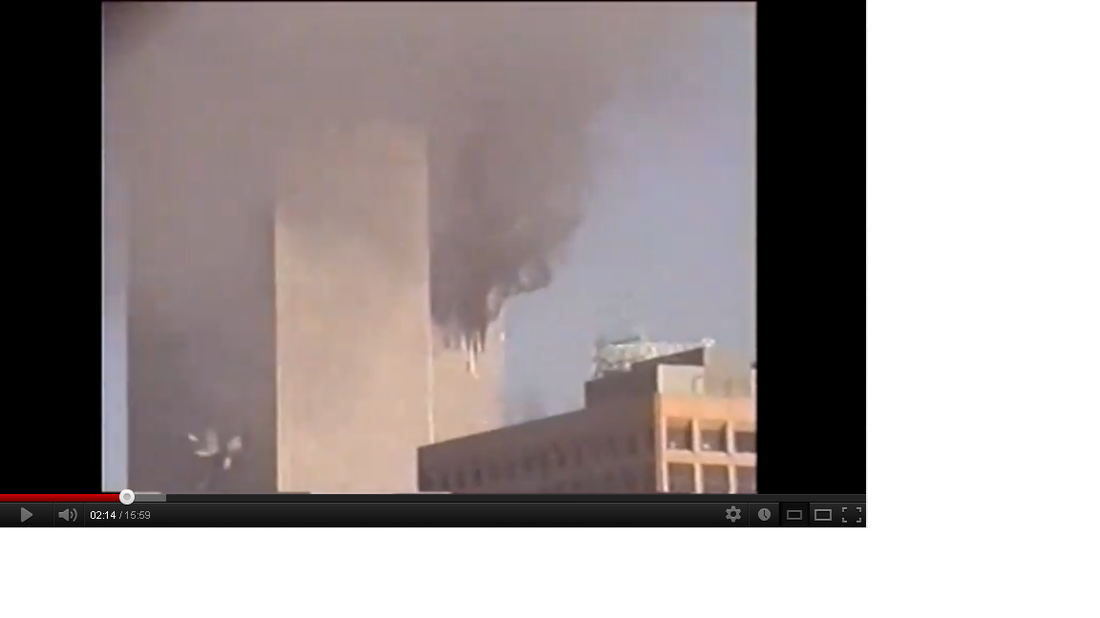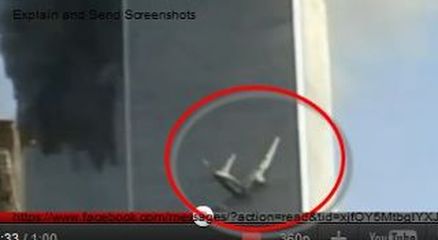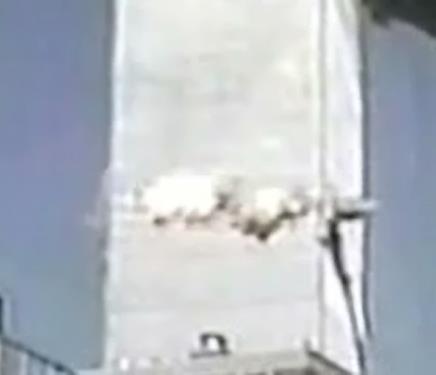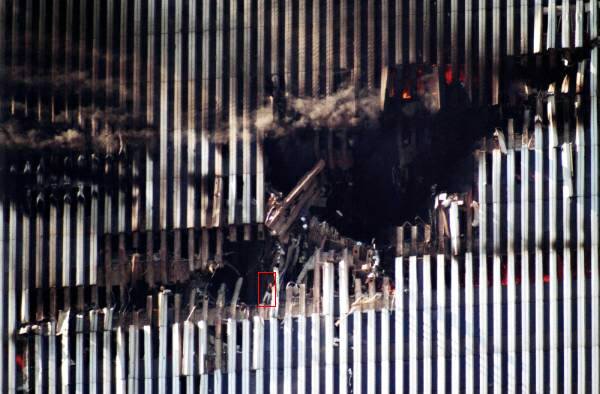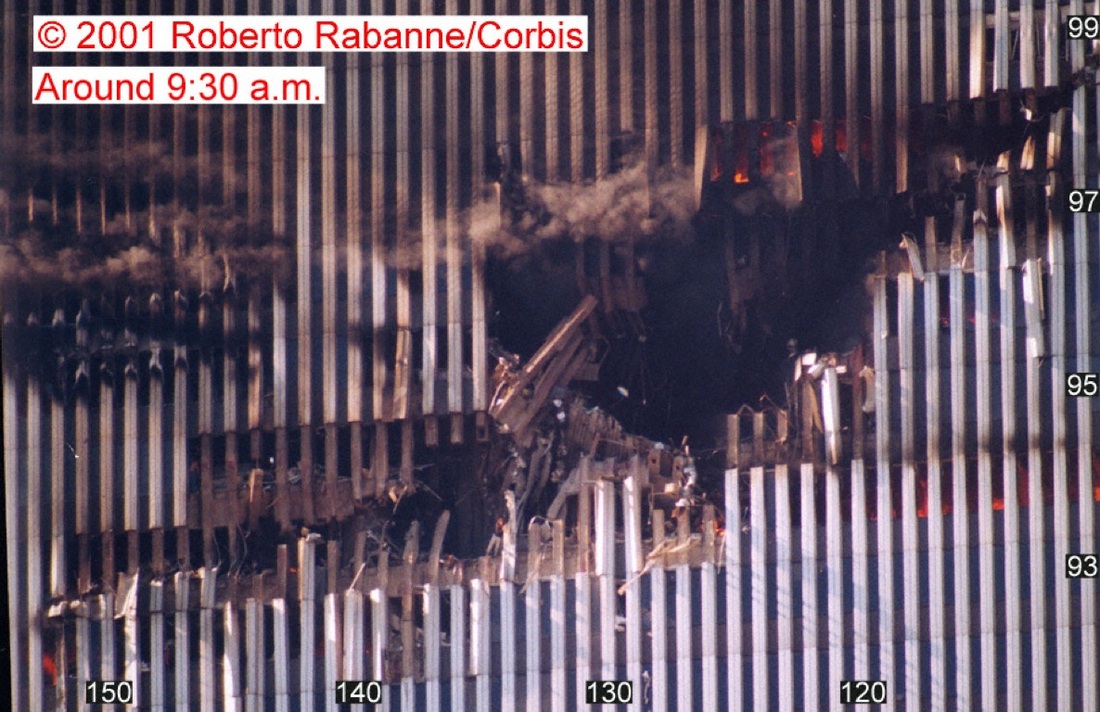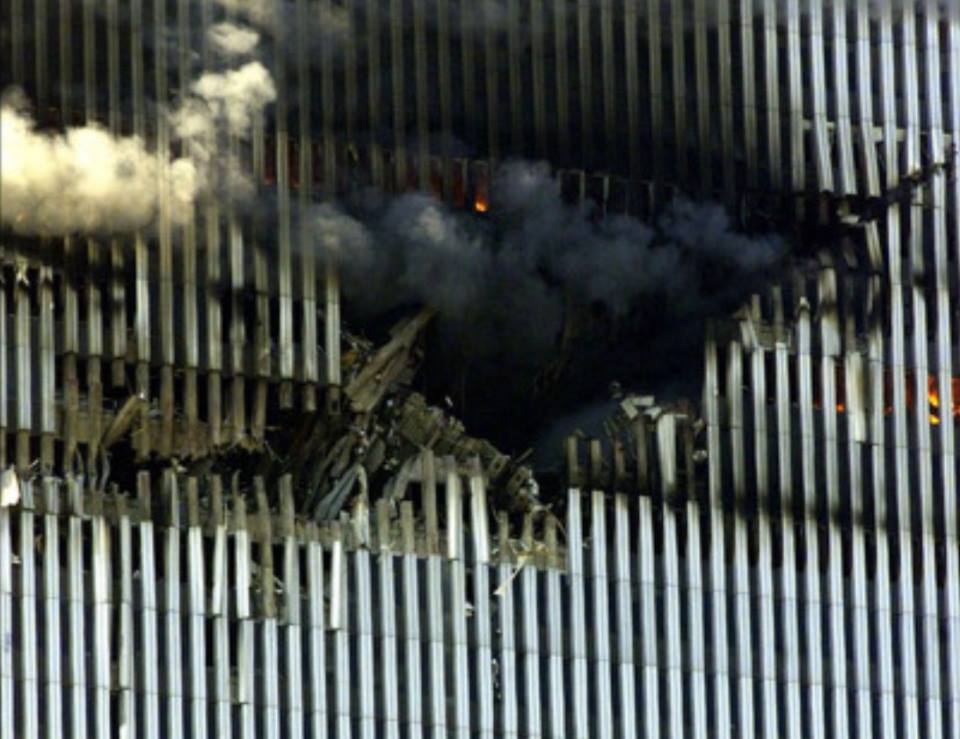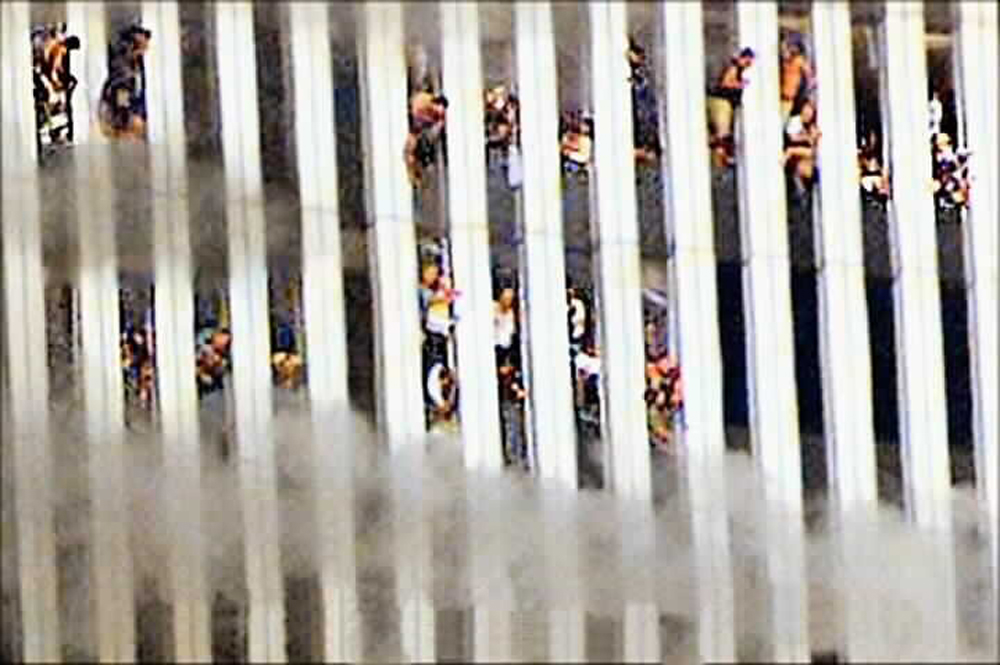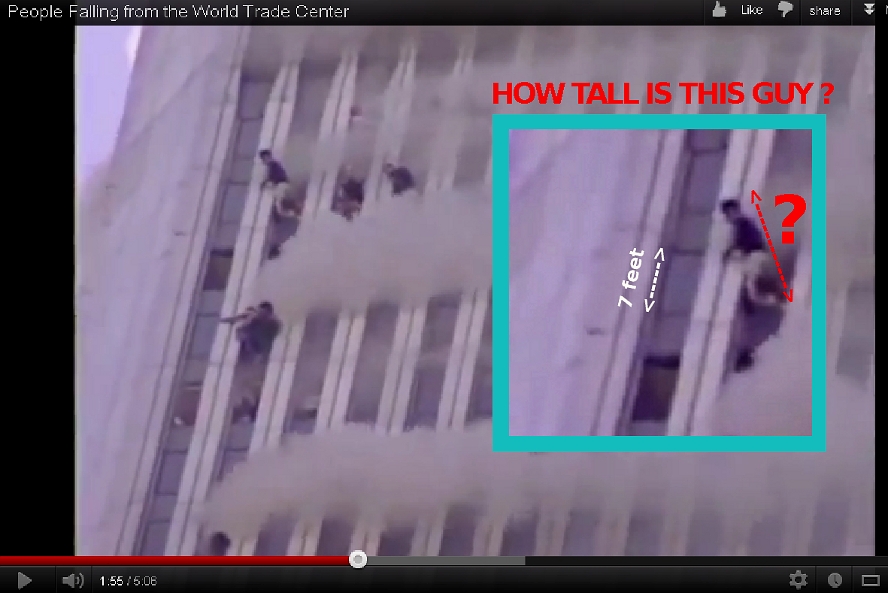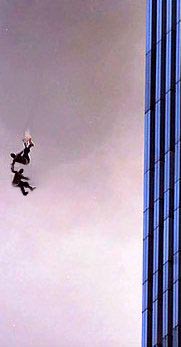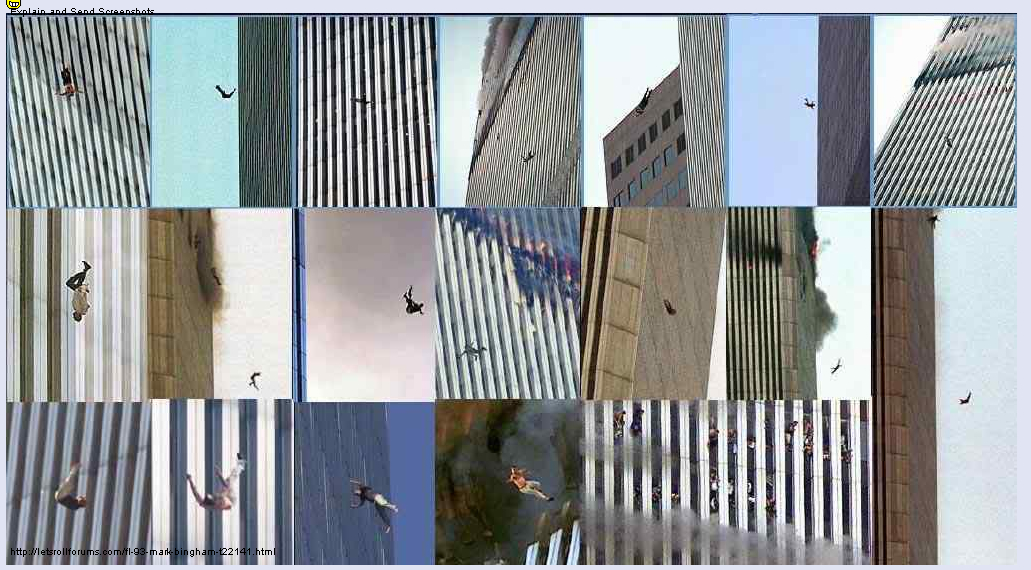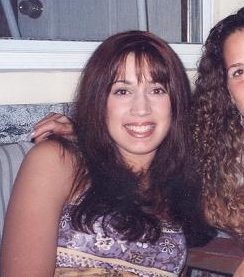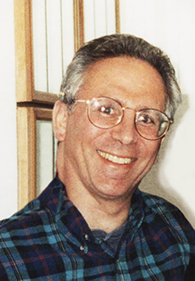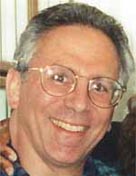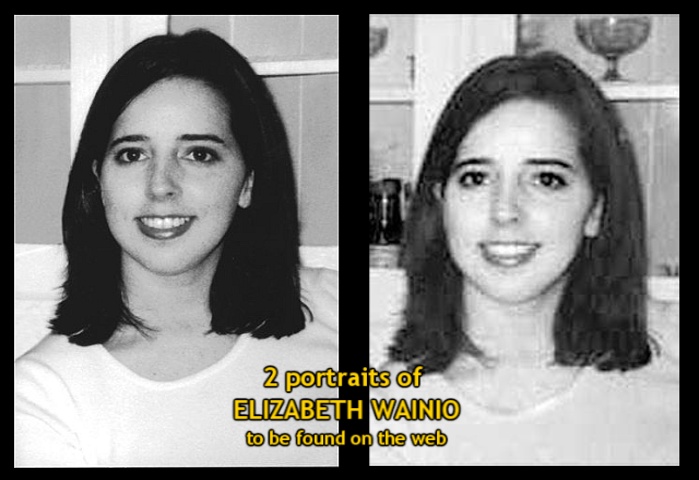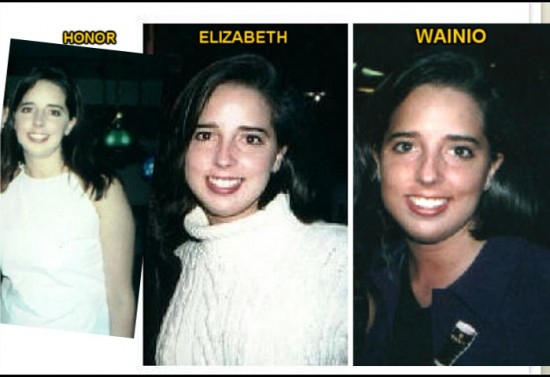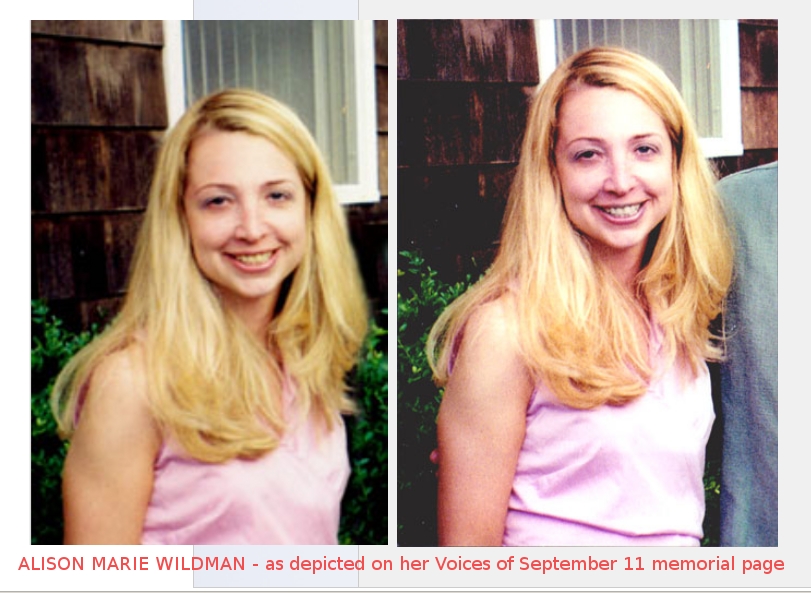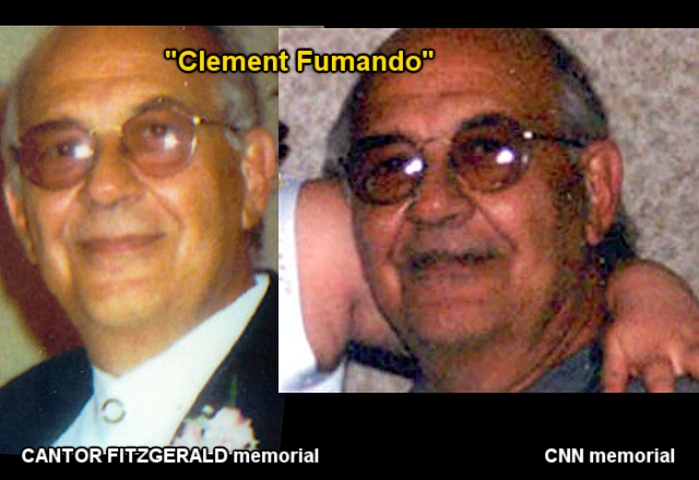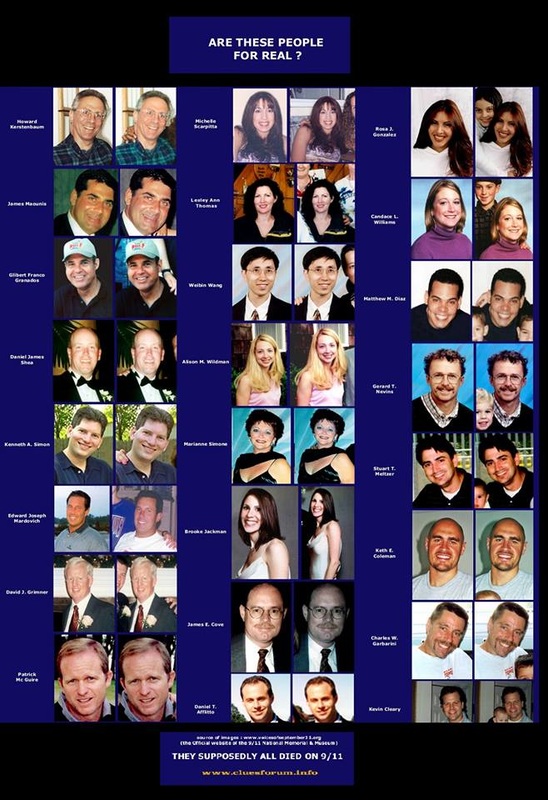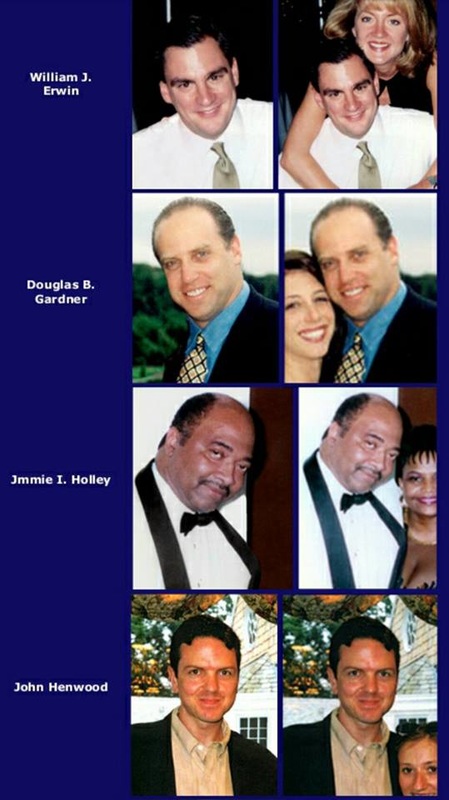LEFT CLICK DOWNLOAD FILE TO PLAY INSTANTLY IN YOUR BROWSER. Right Click To Save To Your PC Or Open The Audio In A new Window Or Tab. The Following Evidence Is A Part Of What We Cover In The Show.
| _jim_fetzer_real_deal-stavely_final_yt.mp3 | |
| File Size: | 66505 kb |
| File Type: | mp3 |
Here is the link for all the 9/11 TV Archives. You can verify all these videos actually were aired on 9/11. They seem to have not been deleted at all. They are broken down into about 15 m sections.http://archive.org/details/sept_11_tv_archive
Below Picture Is Credited To Luc Courchesne
Below Is A Screengrab Of The Herzakhani Video Given To CNN
Does this seriously look real to you??
How About The Below Image Credited To Jennifer Spell??
The Plane is almost all the way in and still no hole in the tower??!!!!!
VIDEO THE ABOVE IMAGE CAME FROM- Jennifer Spell
The Michael Herzakhani Shot As Seen ON CNN
|
Herzakhani Shot RE EDITED For America Remembers DVD. Notice now when he says" OMG a plane has just crashed into building. Pause it. Now do the same to the video on the left. Notice the videos DO NOT MATCH!! Same audio, completely different explosions, smoke, etc.. and from the same perspective!!! |
This Is The Follow Along Page For The Show With James Henry Fetzer On the show With Us.
Below Is Judy Woods "Steel Spire" Video |
Below Image Credited To Reuters And Posted In The Telegraph. In reality the WTC windows were more than double that size!! Ill show you after another image of the ABSURD 9/11 tiny windows image. They are in real life or were in real life 7 feet!!!Another Bullshit 9/11 Image. Now look below. Those are the real size and they are also taken from the 91st fl. The exact same area of the WTC.Most Jumper Images Credited To GammaPress
|
Below Shot Credited To CBS News And Later Re-aired All Over
CARTOON NEW YORK WITH THE LEANING EMPIRE STATE BUILDING AND ALL!! |
A Witness An Actor Or An Architet? I Go With Options 2 & 3 |
|
|
|
|
|
|
Carried a man ut that blew up on the elevator so covered in blood we thought his shirt was red. Nevermind my pristine white Aramark shirt. Or the fact half the antanae is missing from the WTC behind me suggesting video manipulation more specifically some form of green or blue screening.
|
What Did Bush Have The Children Reciting As The "Attacks" Were About To Happen???
How can one event have so many different trajectories on real videos? That's right, It can't!!!
From The Book Divided We Stand By Eric Darton in 1999Eric Darton published in 1999 the most comprehensive 'biography' of the WTC twin towers. It is an essential read for insights into how the towers' tenants might have been 'controlled' - so to speak - after the first 1993 "Al-Qaeda" bombing. 'Divided We Stand' is also a treasure trove for anyone interested in the wheelings and dealings that - historically - have characterized these most cumbersome and disliked buildings.
I have synthesized the most interesting facts listed in the book; here they are - followed by selected extracts of "Divided We Stand":
1- THE TOWERS WERE A SHAMBLES FROM THE WORD GO:
"In 1985, when New York State moved most of its offices out, Dean Witter consolidated its operations in twenty-four floors of Tower 2 under a twenty-year lease. Visiting the brokerage and investment firm's offices and cafeterias, one invariably found them spotlessly maintained. But on adjacent floors, particularly those with multiple tenants, the paint was dingy, the carpets were stained, fixtures remained broken, and burned-out fluorescent lights went unreplaced, as did discolored ceiling tiles. And the listing of a company on the directory did not reliably indicate that a company was still there."
2- FOLLOWING THE 1993 BOMBING, 50,000 workers were displaced and 350 tenants were RELOCATED OUTSIDE THE WTC.
"The February 1993 blast in the basement of the World Trade Center killed 6 people, injured 1,000 others, displaced 50,000 workers, and threw 900 Vista Hotel and Windows on the World employees out of work, but it also provided a modest boost for the regional economy. This, at any rate, was the conclusion the Port Authority came to in an April 1993 report released six weeks after the bombing. (...) For the agency, this silver lining was due in part to the ease with which the 350 bombed-out trade center tenants could be moved into abundant vacant office space nearby."
3- AT THE END OF THE 90'S HUGE QUANTITIES OF OFFICE SPACE WERE ANNOUNCED RENTED - BY THE PRESS
"The Port Authority closed out the 1990s with a stream of press releases announcing the rental of unimaginably huge quantities of trade center office space to "cutting-edge" firms like Sun Microsystems. Yet around the complex a million square feet stood empty, and the buildings originally intended as great catalyzing chambers of world trade were, by degrees, transforming into a kind of disjunctive real estate layer-cake. One story above the carpeted, wood-paneled offices of a Japanese securities firm, a group of artists filled bare walls with boldly colored images and hung sculptures from the exposed ceiling girders of a vast echoing cavern. As part of a Lower Manhattan Cultural Council program that turned some of the vacant space in the towers over to artists rent-free, 40,000 square feet of concrete floor lay paint-spattered and strewn with the raw materials of a creative urge that has never been easily reconciled with the imperatives of a bottom line. "
In any case, let this previous post by our member Brutal Metal be an inspiration to all - in order to overcome this myth:
Brutal Metal wrote:
I thought during the 90's the Twin Towers and the businesses and institutions housed within was considered the Heart/Mother Brain of All the Worlds Financial markets with companies all over the world taking up office space there??
Here is a October 2001 Interview of Darton By Business Week
What The Twin Towers Stood For
Spurred by the destruction of the World Trade Center by terrorists on Sept. 11, 2001, a book that details the story of the towers has had a sudden, sad surge in popularity. Divided We Stand: A Biography of New York's World Trade Center started as a research paper when author Eric Darton was a grad student at the City University of New York, before growing into its final, full-length version, published in 1999. The engrossing book explores the complicated background and development of the World Trade Center. It describes the key political and economic players who were involved, while it also looks at the issues of real estate speculation, squashed community opposition, and controversial financing that swirled around the towers project.
To Darton, these skyscrapers were powerful symbols that marked New York's transition from a seaport to a financial center. Biography is aptly used in the title instead of history, as the author seems to view the buildings -- the "troubled siblings" almost as animate. Recently, Darton spoke with BusinessWeek Contributing Editor Karin Pekarchik. Here are edited excerpts from their conversation:
Q: Do you think the World Trade Center will be rebuilt?
A: Some people are actually saying that, but it's really bravura or bravado, because the actual social pinnings of these things are gone at this point. If we were to rebuild them as a simulation of what they once were, I think we would be at the point where we would no longer need Disneyland, we would actually be living in Disneyland.
That would be a horrifying and tragic, but I also think it is very unlikely to happen for a bunch of reasons. I think that whatever is built there probably won't take the same shape. I don't personally think [a rebuilding] will happen, because I think the desire would be to not just replicate the buildings but to do something bigger and better and more emblematically charged. If they do go for something like that, [it would be] an even more spectacular folly. On the other hand, the [era of building any] financial center [may be] over.
Q: Why is this terrible attack so hard to comprehend?
A: Whoever did this thing really got us where we live: [The World Trade Center] was a tremendous psychic landmark, as well as a physical landmark. [The attack] really undermined our sense of even what Newtonian physics is. It's hard for most of us to imagine that something so solid could be pulverized so quickly and so completely. I think it's spooky for people, on a deep level.
Whoever did this knew much more about us than we do. It was a supremely intellectual act. And one that defies every description of war, because this did not require anything other than [using] our own materials and our energy against us. There's a level of horror to that. That's terrorism. I think it changes the definition of terrorism. It's emotionally catastrophic for people here.
Q: Did your own personal history draw you to this subject?
A: I think I gravitated in this direction because it had certain bearings on my own past. To some extent the World Trade Center had been built when I wasn't paying much attention to the city that I grew up in. And suddenly they were there. I was finding my way back to a period when I really had not been paying attention at all.
Q: I found it disturbing to know that there is a long, tangled ugliness behind the World Trade Center.
A: What really created the biographical aspect [of the book] was as I began studying the buildings...I began feeling that what I was dealing with was really basically troubled siblings. Where they were saying, "we're in trouble, we are trouble." And I began to [think of] them the way you would...someone who couldn't really articulate that they needed help.
In 1993, about nine months into [writing the book], the bombing happened. [In retrospect, it's as if] the buildings were signaling me that something really awful was imminent. And I knew that there was a story here. My own dreadful fate, I guess, is to attempt to look at things that are difficult to look at.
Q: The book tackles some difficult issues. How did you handle writing about them?
A: I think the buildings were difficult for a lot of people to look at, literally. And I think that the social and cultural history also was very difficult for people to look at. I tried -- of course, the book was written before anyone had any anticipation of this horrible calamity -- to make it as palatable a look as possible into what, as you say, was a dark and tangled story.
I really tried to do that at the narrative level, because I thought you can write about anything if you do it beautifully. I remembered John Hersey's Hiroshima and how deeply it affected me when I first read it. And I thought if someone can write about something like that with such grace and sensitivity and humanity, then I thought you can pretty much approach anything.
Q: Do you have a sense of how this event will affect planning -- urban planners, architects, developers, builders -- in New York and elsewhere? Do you think this will be a catalyst for change?
A: I think it's probably too early to say. My sense of it, though, is that planning and building and design are part of a cultural matrix. And different pieces of the culture move, like seismology. Different plates move, like layers. My sense is that one layer has gotten this tremendous jolt. How it's going to affect the other layers of culture, I don't know.
One of the things that's characteristic of the time after the WTC [was built] is the eclipse of the large-scale planning the WTC represents. It was the end of the power-broker era, marked the beginning of the end of the renewal era. What will happen now, I'm not sure. My sense of it [is that] in parts of the world such as Asia and the Pacific Rim, which have been experiencing until fairly recently these enormous economic surges, the skyscraper will retain a symbolic value and be part of that culture.
Q: Why did the World Trade Center become so important to us?
A: When I was looking around for its emblematic content, I realized by itself it didn't have emblematic content. It was, in a sense, empty. The Trade Center really appeared, if anything, to be a gateway, a gateway through which we passed as a culture from an Industrial Age into the Information Age, this New World we live in.
So I came to see it as a gateway, for New York specifically because it coincided with the eclipse of New York's port. New York, prior to the WTC moment, was a city that could finance, make, and transport things. Now, it's largely a symbolic economy, based on real estate and finance. My feeling is that, now that [the towers] are physically gone...we have crossed another threshold.
Q: Do you think there will be a move toward the suburbs and less densely populated areas? Or do you think Manhattan and other cities will remain vibrant?
A: There has been, for years, pressure from different sources to decentralize the major cites. There was kind of a war going on between the various factions of the ruling class in this country over whether to get out of cities or to concentrate in cities. New York used to be center for all the big banks. [Now,] there are others, including the Bank of North Carolina, that are really huge. There has been a large-scale movement to decentralize, and I can't but imagine that [the terrorist attacks] won't help but fuel that somehow.
Q: What made an impression on you in how people reacted to the attacks?
A: When [the buildings were about to fall,] the Port Authority said, "Stay at your desks. Keep working." Some people said O.K. Some people, mostly women, said, "Uh-uh. We're out of here." The men that I know are in the greatest level of denial about this. Who are the ones that are shrieking about rebuilding this thing? The guys.
Editor's Note: Basic Books has anounced it will donate a portion of the profits from sales of Divided We Stand from Sept. 11 through Dec. 31, 2001 to various charities that will benefit victims' families and survivors of the World Trade Center disaster.
I have synthesized the most interesting facts listed in the book; here they are - followed by selected extracts of "Divided We Stand":
1- THE TOWERS WERE A SHAMBLES FROM THE WORD GO:
"In 1985, when New York State moved most of its offices out, Dean Witter consolidated its operations in twenty-four floors of Tower 2 under a twenty-year lease. Visiting the brokerage and investment firm's offices and cafeterias, one invariably found them spotlessly maintained. But on adjacent floors, particularly those with multiple tenants, the paint was dingy, the carpets were stained, fixtures remained broken, and burned-out fluorescent lights went unreplaced, as did discolored ceiling tiles. And the listing of a company on the directory did not reliably indicate that a company was still there."
2- FOLLOWING THE 1993 BOMBING, 50,000 workers were displaced and 350 tenants were RELOCATED OUTSIDE THE WTC.
"The February 1993 blast in the basement of the World Trade Center killed 6 people, injured 1,000 others, displaced 50,000 workers, and threw 900 Vista Hotel and Windows on the World employees out of work, but it also provided a modest boost for the regional economy. This, at any rate, was the conclusion the Port Authority came to in an April 1993 report released six weeks after the bombing. (...) For the agency, this silver lining was due in part to the ease with which the 350 bombed-out trade center tenants could be moved into abundant vacant office space nearby."
3- AT THE END OF THE 90'S HUGE QUANTITIES OF OFFICE SPACE WERE ANNOUNCED RENTED - BY THE PRESS
"The Port Authority closed out the 1990s with a stream of press releases announcing the rental of unimaginably huge quantities of trade center office space to "cutting-edge" firms like Sun Microsystems. Yet around the complex a million square feet stood empty, and the buildings originally intended as great catalyzing chambers of world trade were, by degrees, transforming into a kind of disjunctive real estate layer-cake. One story above the carpeted, wood-paneled offices of a Japanese securities firm, a group of artists filled bare walls with boldly colored images and hung sculptures from the exposed ceiling girders of a vast echoing cavern. As part of a Lower Manhattan Cultural Council program that turned some of the vacant space in the towers over to artists rent-free, 40,000 square feet of concrete floor lay paint-spattered and strewn with the raw materials of a creative urge that has never been easily reconciled with the imperatives of a bottom line. "
In any case, let this previous post by our member Brutal Metal be an inspiration to all - in order to overcome this myth:
Brutal Metal wrote:
I thought during the 90's the Twin Towers and the businesses and institutions housed within was considered the Heart/Mother Brain of All the Worlds Financial markets with companies all over the world taking up office space there??
Here is a October 2001 Interview of Darton By Business Week
What The Twin Towers Stood For
Spurred by the destruction of the World Trade Center by terrorists on Sept. 11, 2001, a book that details the story of the towers has had a sudden, sad surge in popularity. Divided We Stand: A Biography of New York's World Trade Center started as a research paper when author Eric Darton was a grad student at the City University of New York, before growing into its final, full-length version, published in 1999. The engrossing book explores the complicated background and development of the World Trade Center. It describes the key political and economic players who were involved, while it also looks at the issues of real estate speculation, squashed community opposition, and controversial financing that swirled around the towers project.
To Darton, these skyscrapers were powerful symbols that marked New York's transition from a seaport to a financial center. Biography is aptly used in the title instead of history, as the author seems to view the buildings -- the "troubled siblings" almost as animate. Recently, Darton spoke with BusinessWeek Contributing Editor Karin Pekarchik. Here are edited excerpts from their conversation:
Q: Do you think the World Trade Center will be rebuilt?
A: Some people are actually saying that, but it's really bravura or bravado, because the actual social pinnings of these things are gone at this point. If we were to rebuild them as a simulation of what they once were, I think we would be at the point where we would no longer need Disneyland, we would actually be living in Disneyland.
That would be a horrifying and tragic, but I also think it is very unlikely to happen for a bunch of reasons. I think that whatever is built there probably won't take the same shape. I don't personally think [a rebuilding] will happen, because I think the desire would be to not just replicate the buildings but to do something bigger and better and more emblematically charged. If they do go for something like that, [it would be] an even more spectacular folly. On the other hand, the [era of building any] financial center [may be] over.
Q: Why is this terrible attack so hard to comprehend?
A: Whoever did this thing really got us where we live: [The World Trade Center] was a tremendous psychic landmark, as well as a physical landmark. [The attack] really undermined our sense of even what Newtonian physics is. It's hard for most of us to imagine that something so solid could be pulverized so quickly and so completely. I think it's spooky for people, on a deep level.
Whoever did this knew much more about us than we do. It was a supremely intellectual act. And one that defies every description of war, because this did not require anything other than [using] our own materials and our energy against us. There's a level of horror to that. That's terrorism. I think it changes the definition of terrorism. It's emotionally catastrophic for people here.
Q: Did your own personal history draw you to this subject?
A: I think I gravitated in this direction because it had certain bearings on my own past. To some extent the World Trade Center had been built when I wasn't paying much attention to the city that I grew up in. And suddenly they were there. I was finding my way back to a period when I really had not been paying attention at all.
Q: I found it disturbing to know that there is a long, tangled ugliness behind the World Trade Center.
A: What really created the biographical aspect [of the book] was as I began studying the buildings...I began feeling that what I was dealing with was really basically troubled siblings. Where they were saying, "we're in trouble, we are trouble." And I began to [think of] them the way you would...someone who couldn't really articulate that they needed help.
In 1993, about nine months into [writing the book], the bombing happened. [In retrospect, it's as if] the buildings were signaling me that something really awful was imminent. And I knew that there was a story here. My own dreadful fate, I guess, is to attempt to look at things that are difficult to look at.
Q: The book tackles some difficult issues. How did you handle writing about them?
A: I think the buildings were difficult for a lot of people to look at, literally. And I think that the social and cultural history also was very difficult for people to look at. I tried -- of course, the book was written before anyone had any anticipation of this horrible calamity -- to make it as palatable a look as possible into what, as you say, was a dark and tangled story.
I really tried to do that at the narrative level, because I thought you can write about anything if you do it beautifully. I remembered John Hersey's Hiroshima and how deeply it affected me when I first read it. And I thought if someone can write about something like that with such grace and sensitivity and humanity, then I thought you can pretty much approach anything.
Q: Do you have a sense of how this event will affect planning -- urban planners, architects, developers, builders -- in New York and elsewhere? Do you think this will be a catalyst for change?
A: I think it's probably too early to say. My sense of it, though, is that planning and building and design are part of a cultural matrix. And different pieces of the culture move, like seismology. Different plates move, like layers. My sense is that one layer has gotten this tremendous jolt. How it's going to affect the other layers of culture, I don't know.
One of the things that's characteristic of the time after the WTC [was built] is the eclipse of the large-scale planning the WTC represents. It was the end of the power-broker era, marked the beginning of the end of the renewal era. What will happen now, I'm not sure. My sense of it [is that] in parts of the world such as Asia and the Pacific Rim, which have been experiencing until fairly recently these enormous economic surges, the skyscraper will retain a symbolic value and be part of that culture.
Q: Why did the World Trade Center become so important to us?
A: When I was looking around for its emblematic content, I realized by itself it didn't have emblematic content. It was, in a sense, empty. The Trade Center really appeared, if anything, to be a gateway, a gateway through which we passed as a culture from an Industrial Age into the Information Age, this New World we live in.
So I came to see it as a gateway, for New York specifically because it coincided with the eclipse of New York's port. New York, prior to the WTC moment, was a city that could finance, make, and transport things. Now, it's largely a symbolic economy, based on real estate and finance. My feeling is that, now that [the towers] are physically gone...we have crossed another threshold.
Q: Do you think there will be a move toward the suburbs and less densely populated areas? Or do you think Manhattan and other cities will remain vibrant?
A: There has been, for years, pressure from different sources to decentralize the major cites. There was kind of a war going on between the various factions of the ruling class in this country over whether to get out of cities or to concentrate in cities. New York used to be center for all the big banks. [Now,] there are others, including the Bank of North Carolina, that are really huge. There has been a large-scale movement to decentralize, and I can't but imagine that [the terrorist attacks] won't help but fuel that somehow.
Q: What made an impression on you in how people reacted to the attacks?
A: When [the buildings were about to fall,] the Port Authority said, "Stay at your desks. Keep working." Some people said O.K. Some people, mostly women, said, "Uh-uh. We're out of here." The men that I know are in the greatest level of denial about this. Who are the ones that are shrieking about rebuilding this thing? The guys.
Editor's Note: Basic Books has anounced it will donate a portion of the profits from sales of Divided We Stand from Sept. 11 through Dec. 31, 2001 to various charities that will benefit victims' families and survivors of the World Trade Center disaster.
ACE BAKER"S ON AIR SUICIDE
Brian S Staveley's Call Into Judy Wood's Radio Show
| 9-4-12_judy_wood_cal_higher_volume.ogg | |
| File Size: | 9599 kb |
| File Type: | ogg |
